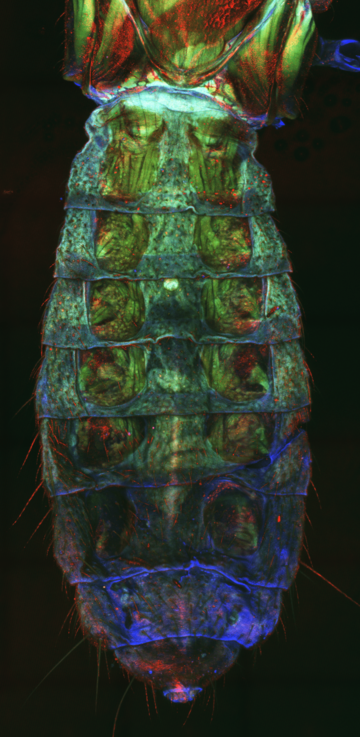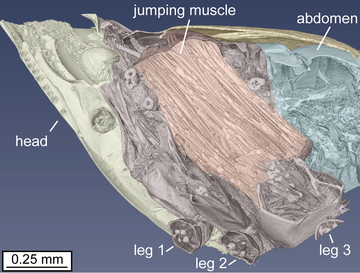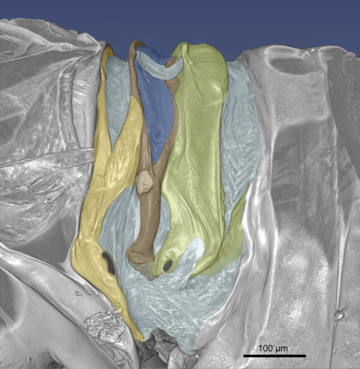Dr Leonidas-Romanos Davranoglou
ORCID ID: 0000-0002-3447-4242

Research summary
Leonidas's research aims to elucidate the origins of sound production in some of nature's greatest singers – the cicadas and their relatives (hemipteran insects). He will be tackling questions that have vexed entomologists for decades, namely:
- Why did microscopic hemipterans ever start to communicate with sounds and substrate-borne vibrations?
- Did these behaviours evolve only once?
- How do their sound-producing organs work?
- Can these sound-producing organs inform us about the evolution of communication in small animals in general?
To answer the above, Leonidas will use state-of-the-art techniques such as X-ray microtomography, laser Doppler vibrometry, and high-speed cameras. Together with engineers, he will attempt to reconstruct the morphology and biomechanics of the vibrational organs of extinct Hemiptera preserved in 100-million-year-old amber, thereby opening a new window on the acoustic landscape of Cretaceous forests.
Leonidas is a taxonomist at heart, and he leads several research expeditions that document arthropod biodiversity worldwide. the beetle Augyles davranogloui is named in his honour.
CV
Leonidas-Romanos Davranoglou is a Leverhulme Trust Early Career Fellow at the Museum, his Fellowship also receiving the generous support of the John Fell OUP Fund. Prior to his Fellowship, Leonidas undertook his DPhil (2015-2020) research in insect morphology and biomechanics at the Department of Zoology, University of Oxford, under the supervision of Professor Graham Taylor and Dr Beth Mortimer. For his undergraduate degree (B.Sc. Hons.), Leonidas studied Zoology at Imperial College London (2012-2015).

The abdomen of a unique-headed bug (Lomagostus sp.) as seen through a confocal laser scanning microscope. Examination of its morphology shed light on how the stink bugs’ stink evolved! Publication: Davranoglou et al. (2017).

Micro-CT section of a microscopic planthopper, illustrating the jumping mechanism of a planthopper. Publication: Davranoglou et al. (2022, in preparation). © Leonidas-Romanos Davranoglou.

An entirely novel vibrational mechanism was discovered by Leonidas and his team, known as the “snapping organ” – imaged here with synchrotron micro-CT. This organ allows planthopper bugs to communicate with vibrations for reproductive and territorial purposes. Publication: Davranoglou et al. (2019).
Featured publications
All Publications
McGavin, G. & Davranoglou, L.-R. (2021) Essential Entomology: An Order-by-Order Introduction. Second Edition. Oxford University Press (book in preparation).
Davranoglou, L.-R., Taylor, G.K.T., Mortimer, B. & Malenovsky, I. (2020) On the morphology and evolution of cicadomorphan tymbal organs. Arthropod Structure & Development 55, 100918.
Davranoglou, L.-R., Cicirello, A., Taylor, G.K. & Mortimer, B., 2019. Planthopper bugs use a fast, cyclic elastic recoil mechanism for effective vibrational communication at small body size. PLoS Biology 17, e3000155.
Davranoglou, L.-R., Matsumoto, K., Soh, Z. & Kempton, J. (2021) New records and ecological observations on Greek cave crickets (Orthoptera: Rhaphidophoridae). Journal of Natural History, 55 (1–2), 1–13.
Hlaváč, P., Baňař, Davranoglou, L.-R. & Kempton, J. (2021) Endogean and Cavernicolous Coleoptera of the Balkans. XXIII. A new species of Paramaurops J. Müller (Coleoptera: Staphylinidae: Pselaphinae) from Greece. Zootaxa, 4970 (1), 195–200.
Davranoglou, L.-R. & Karaouzas, I. (2021) Further distributional records of Lethocerus patruelis (Stål, 1854) (Heteroptera: Belostomatidae) in Greece. Ecologica Montenegrina, 41 (1), 56–61.
Davranoglou, L.-R., Taylor, G.K.T., Mortimer, B. & Malenovsky, I. (2019) The morphology of vibroacoustic mechanisms in derbid planthoppers (Hemiptera: Fulgoromopha: Derbidae). Arthropod Structure & Development, 52, 100880.
Chlond, D., Guilbert, E., Faille, A., Baňař, P. & Davranoglou, L.-R. (2018) A remarkable new species of cavernicolous Collartidini from Madagascar (Hemiptera: Heteroptera: Reduviidae). Zootaxa, 4425, 372–385.
Davranoglou, L.-R., Baňař, P., Schleputz, C., Mortimer, B. & Taylor, G.K. (2017) The pregenital abdomen of Enicocephalomorpha and morphological evidence of different modes of communication at the dawn of heteropteran evolution. Arthropod Structure & Development, 46, 843–868.
Davranoglou, L.-R. (2016) Redeicephala taylori, a new genus and species of Reduviidae from New Guinea, with notes on a few morphological features of the Tribelocephalinae (Hemiptera: Heteroptera). Acta Entomologica Musei Nationalis Pragae, 56, 39–50.
Baňař, P., Davranoglou, L.-R. & Chlond, D. (2016) A new species of Henicocephaloides from Eastern Madagascar (Hemiptera: Heteroptera: Reduviidae). Entomologica Americana, 122, 238–244.
Davranoglou, L.-R., Hwang, W.S. & Weirauch, C. (2015) Neotropical Physoderinae revisited, with description of a new, sexually dimorphic species of Leptophysoderes Weirauch (Hemiptera: Reduviidae). Zootaxa, 3963, 89–99.
Davranoglou, L.-R. (2014) A new micropterous species of Physoderes from the Fiji (Heteroptera: Reduviidae: Physoderinae). Zootaxa, 3838, 233–241.




